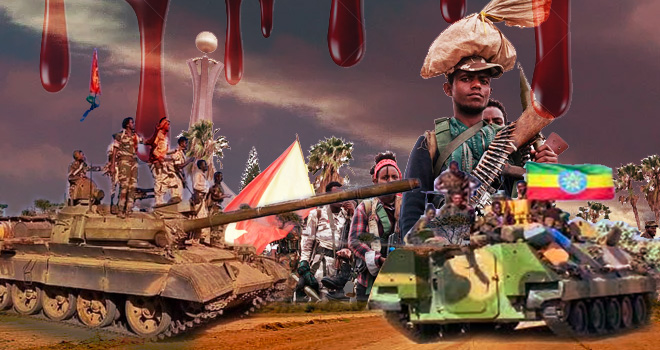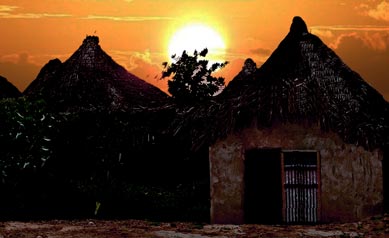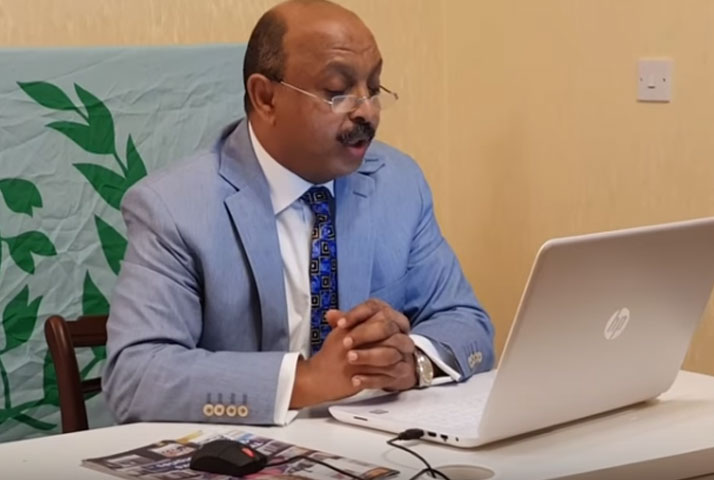A Possible Political Collusion Course

Tigray’s TPLF, Eritrea’s EPLF, and Ethiopia’s Prosperity Party at a Possible Political Collusion Course: Whatever the Outcome, it will Redefine the Horn of Africa for Decades to Come.
Respectful, rigorous, and intellectually engaging confrontation of ideas is always a welcome gesture; one that focuses on ideas rather than on a person; one that focuses on the message, rather than the messenger; it will go a long way in enhancing and helping us reach to a mutual understanding than the endless bickering, insulting, verbally assaulting one’s interlocutors, which brings no positive outcome. For the sakes of the young who are perishing in the war, if we can’t offer our prayers, to borrow a biblical allusion, the “hewers of wood and drawers of water”, the least we can do is have a spirited dialogue. Thus, this piece is being penned with that in mind. Rebuttal to your heart’s content, just keep it civil – in an article form if you so wish or in the forum below. Let us have it.
Here is the field, let’s scribble
One must give an accolade of sorts to the propaganda machination that TPLF has created, which works like a well-oiled wheel. It knows in the digital age, to borrow Josh Billings’s one stanza poetry, “I hate to be a kicker, / I always long for peace, / But the wheel that does the squeaking the [loudest], / is the one the gets the grease”. Hopefully, a prospect of peace, at last, wins out. But with the kind of noise that TPLF and its supporters do, given the recent conversation that Heritage Foundation, a conservative Think Tank did with General Tsadkan, the peace prospect will be highly unlikely. The General still has some stamina left in him to go to war. But then again, that’s like going against the tide of reality, i.e., a peace agreement in the Horn of Africa’s parlance is a precursor to a war that would follow no matter how long it might take. It is not to find a lasting peace but to outwit one’s enemy under the guise of peace talks.
Therefore, it is no surprise the prospects of peace appear to be trumped by war in our region. Each time the people of Eritrea and Ethiopia dream of peace, the war manages to find its way to disrupt any hints of it for many years to come. Consider 1991: Eritreans were elated, at long last, peace seemed to be the only prospect moving forward, after three decades of war for independence of the young nation. It took only seven years for the war between Ethiopia and Eritrea to unfold – make that between TPLF and EPLF. The cessation of hostilities between the two countries didn’t seem to do anything else but keep the no-war-no-peace to continue in hibernation waiting to reemerge at an opportune moment for this old time, now friends and now nemesis to start anew. True to form, war couldn’t just flare up without a peace accord. They must keep the pattern straight. And so it was: Peace accord was signed between Ethiopia under Abiy Ahmed leadership in 2018, which sidelined the TPLF that was in power for 27 years. In 2020, Ethiopia’s civil war between the Federal government and a region in the Northern tip of the country broke out that left no room for Eritrea to stay aside.
Thus, the war has been raging off and on between the Federal government and the Tigray region for two years now and counting. But some vehemently argue and counter-argue why should Eritrea intervene in a neighboring country’s internal affairs. Well, listening to experts in the field who know the region from first-hand experience and intimately at that might prove instructive here. This is nothing new say experts of the region, mentioning boundaries, war, peace, interventions, diplomacy, using historical accounts. Talking about issues is one thing but thrashing and trashing individual leaders is another; however, that remains par for the course in our discourse. So, Isaias Afewerki is a punching bag of many frustrated activists, has been, will continue to be, this one is no exception either – I have my shares of it. Everyone who considers himself/herself a justice seeker is guilty as charged here. Do such actions of tarnishing individual leaders serve the intended purpose? Let us use Isaias Afewerki (IA) as an Exhibit A to put such a notion to a test.
Isaias Afewerki (IA) is, arguably, at the top of his craft. Be it the quicksand or the sandcastle metaphors didn’t deter the man from staying in power far longer than a castle built in a sand. Or the longest critique of IA, Dr. Tesfatsion Medhanie, in the book he penned in the mid-eighties or a little later. When someone gave me to read the book, the only thing I remember, some three score years later is this: The personal attack to IA. I found such ad hominem attacks an unnecessary political tool that Eritrean political actors tend to gravitate towards. Former Ambassador Andebrahn Woldegiorgis is no exception. He managed to enter the personal attack at IA in his book, “Eritrea at a Crossroads…”. The brave Brhane Abrehe who decided to publish his book while in Eritrea, several years ago now, exactly as Saleh Younis predicted, I couldn’t read beyond the personal attacks the author decided to level at the origin of IA as if that would make the man less Eritrean. Clearly, there is a political legacy that goes back to the mid-eighties as late as several years ago, where personal attacks find entry points in books. Cognizant of such a legacy, when he decided to offer his own perspective, Saleh Younis aptly points out and acknowledges the various selective perspectives that one must consider. Thus, he prefaces his remarks as follows:
“There are different perspectives. If you are, say, a veteran of the Eritrean Liberation Front (ELF), you may have one perspective. If you are a supporter of the Eritrean People’s Liberation Front (or someone who eventually reconciled with the reality that it is the sole liberation front), you may have another. If you are a PFDJ-supporter, you may have another. If you are a post-PFDJ Eritrean, you may have another. If you don’t care about any of that at all and only consider removal of Isaias Afwerki from power as your sole priority, you will have another. If you are a TPLF-supporter, a Tigrayan Ethiopian or someone who is unwilling to consider the context of explicitly racist expressions, I doubt you will get past page 41: it is just too much to take for you.”1
The above merely scratches the surface. Today, optics are plenty and so seem ad hominem attacks in equal proportion. The aan media network crew managed to enter the fray by going the same place that Berhane Abrehe did that Saleh Younis – rightly – characterized as “racist”. This notion of pure Eritreans, wishing to cleanse Eritrea from Tigray is not only wrongheaded but is unbelievably naïve assertion to even entertain. This bears repeating over and over: That any Eritrean worthy his/her salt, who considers a highland part of his identity cannot disentangle from Tigray his/her heritage. It is a matter of degrees of separation. Eritreans are not fighting to separate themselves from Tigray. They have already established their identity as Eritreans as distinct as many other countries have done. African countries abide by colonial boundaries, why shouldn’t Tigray or Ethiopia for that matter. Canada and the US do not fight because each has a country to which it belongs. Their heritages are not too far apart. They all point to Europe. Eritreans should never shy away from acknowledging their heritage points to Tigray. But that should never be the basis for uniting Eritrea and Tigray. The latter belongs to Ethiopia. Period. If it wants to go its separate ways from the rest of Ethiopia, it should never come at the expense of Eritrea. The political landscape is so muddled and muddied, unless and until TPLF relents there can be no peace between the two neighbors (more a little later).
We continue to define and redefine, analyze, and reanalyze, assess, and reassess everything under the sun about the man leading Eritrea. Seemingly very little is done, however, to question our own strategies, our own approaches, and our own tactics to effect change in Eritrea. aan, managed to insert its unwavering distinction between the handful leaders of Eritrea and the Eritrean people as if these Eritrean leaders are aliens. Though some may have not detected it why. I attributed such a hiccup in judgment to the ninth anniversary of Lampedusa as I did my own detour and read the Awate Pencil from that year. The pain was real. Well, a day or two later, a social media commentator danced his way back slickly noting to his capacity as a commentator.
Why have we not produced the results we sought? Why do we at every turn in the struggle for change tend to squabble instead of focusing our attention to what we believe our main objectives are: Seeking Change. Do we expect change will come by repudiating those who are in the same camp as us fighting for the same vision? Why? Why can’t we minimize our differences and work toward the overarching goals we all claim to have? Recalling the Lampedusa tragedy on its 9th anniversary is instructive here to illustrate one glaring point; for it galvanized Eritreans the world over like no other up to then. There were petitions going around seeking the resignation of the man at the helm of power as if he was an elected official. What does that speak to? Does it speak to our lack of a coherent goal or lack of knowing the path to the fundamental changes we endeavor to see in Eritrea. For the record, I was for it, simply put, personally, didn’t know what else to do. The phase of signing petitions has ebbed and flowed, finally, however, appears to be waning while the hold of political power by the regime in Eritrea appears to be on solid grounds, intact, if you will. There, however, seems to NOT be anything remotely close to evaluating it why.
Just Move Foreword
If anything, Eritrea is on solid grounds while former EPRDF, today’s TPLF, is diminished drastically. In fact, it is on the throes of becoming history like those of Columbia’s FARC if the peace talks in South Africa produce any results. Otherwise, TPLF may go in history as that of Sri Lankan Tamil Tigers who were neutralized in May of 2009. The choice is starkly clear in front of TPLF to make for the sake of Ethiopians and for the sake of the region, and above all, for the sake of the people of Tigray. Cut your losses and seek peace ought to be the mantra from all who claim to have any fiber of humanities in them. What about the people of Eritrea, you wonder? No need to wonder, for Eritreans are protecting their land, their people, by themselves, for themselves, thank you!
A little data on Eritrean population
According to the UN’s World Population Review that came out earlier this summer, “there are 1,963,504 people over age 18 in Eritrea.4” So, for those who try to use an anomaly, whether doctored or real Eritrean POWs, as if that’s a representative sample misconstrues the facts entirely. But then, we know how the TPLF propaganda machination goes wildly beyond speculations when they present their alternative facts as facts. If anecdotal examples can be used as an indication of what Eritrea has been doing since it instituted SAWA is this: Out of all the young Eritreans it sends to SAWA, a trusted source said that 17% enter a military profession. These are young men and women who would become elites in their profession and spend their career in their respective forces. Do the math, for a little over two decades, Eritrea has been doing this. To say that its military force is comprised of old and decrepit is to undermine an enemy to one’s own peril. So far, the facts speak for themselves, Eritrea is well protected garrison, all that TPLF can do is try to penetrate those territories, forcefully defending the country and its people will continue to be the response.
As I was doing some perfunctory search while writing this article, I came across my own piece, the concluding remarks of which I am liberally borrowing below as we are still bickering, and that’s how it was a decade and a half ago, it is sure does not seem any different now.
“The attack mongering and this sphere of intimidation is etched in the highland Eritreans’ mind set, which needs to be disposed of, much like the Hamas style of politicking and not far from that of Taliban needs some serious thought, thoughts that can lead to eradicating such line of thinking; its destructive nature is well apparent in the way any Eritrean who opposes certain line of thinking is hastily labeled as “Agame” as if none of the highlanders roots were from there. Talk about self-hatred: No other ethnic group that I know dismisses one’s own roots within Eritrea in a way we the highlanders do, all for the sakes of a very short-sighted political axe to grind.[…]
“Paying homage to the transnational fighters, those that are alive and those that passed on, no less, deserve our utmost respect. Eritreans did not just fight from within the field, but across the oceans and over the terrains of African plateaus; and the deserts of sub-Saharan Africa, in it being consumed and subsumed to bring forth a nation that they could call their own, which is now being claimed by a handful leaders who think they know what’s best for this new nation and extending the struggle years of butchering and liquidating whoever else that gets in the way will not do the country an iota of good3.
References
- Younis, S. (2018). Berhane Abrehe: How to defeat a human tornado. Retrieved on 10/8/2022 https://www.eritreadigest.com/berhane-abrehehow-to-defeat-a-human-tornado/
- United Nation (2022). Eritrea population 2022 (Demographics, Maps, Graphs)
- Negash, B. (2007). EFLNA/ENASA (Mengisteab Yisaq, Petros Yohannes) and EPLF. (a) (a)Retrieved 10/7/2022. EFLNA/ENASA(Mengisteab Yisaq, Petros Yohannes) & EPLF. (b) Retrieved on 10/7/2022. Eritrea’s socio-politics of slash and burn.



Awate Forum